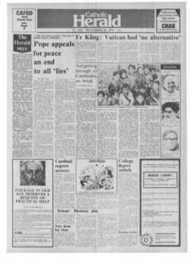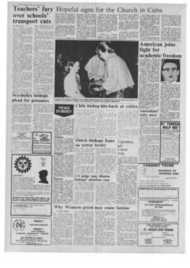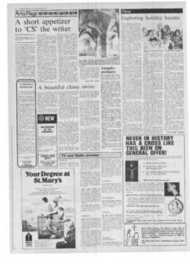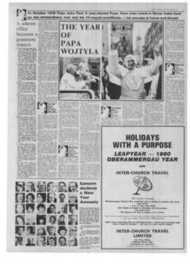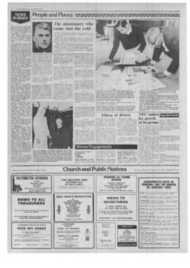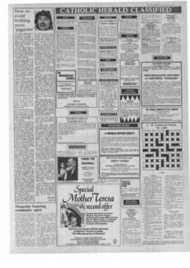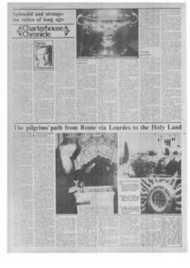Page 10, 28th December 1979
Page 10

Report an error
Noticed an error on this page?If you've noticed an error in this article please click here to report it.
Tags
Share
Related articles
Relics That Recall The Golden Age Of English Catholicism
Vatican Concern At Theft Of Church Art Treasures
A 10 Cath Oli C Heraw Fri Da Y, Fl,
Enduring Dublin Of James Joyce
Dumbing Down In South Kensington
Splendid and strange the relics of long ago
museums as museums I recommend Dublin. True they' are a trifle desolate and seem seldom crowded. The National Gallery. is not crowded with masterpieces, hut it is fascinating in a rather sad w a \ . The National Nluscum k weird.
I or example, it hasL great glass fromed ease full of various papal uniforms .1nd opposite. a mostly 19th cs.aiinr, Neapolitan crib. I he 0-011111c is that though the Irish I urnished most of the troops and a lot or the adminktritiors and died of die usual le \ er as easily as the I: liglish in heathen parts, they did not get their share of the Imperial 1001
\lore than that. their inasterple,es from great country and city mansions tended to get sold in London for the beim• priee and higher prestige, And Impland swizzed Ireland out I n important collection of piet tires 1) n a nasty legal teyhtmality.
This is not to saythat they are not yy■alli isiting. They are a must Piricul.irl ii .you care a particle tor the history. of that distressful and \ et still somehow enY table country. But there is one plaee that I call never resist. It is
U] the ational 'Museum built in the erand and extra% agant and Ieak and classical and mipossible nalish municipal manner.
I one end ol the great hall mere is I ection deyoted to early Irish religious Objects. It takes time, heeause apart from their fierce. angular shapes, they must he stared ,it in detail. I cannot see wit\ the Irish faithful do not approach this place On their knees. It contains some. perhaps 1110.,t, of their most sacred relee renes
licre is St Patrick's bell. A wind! Lire:: hand bell for use at \ Liss or lot waking up ■.1 whole monastery full of monks from their dm ik huts in the dawn. Itv, used at the great Irish Eucharistic Congress in 1932 when they fated Out a troop or caparisoned dragoons to escort the Papal Legate through Dublin. 'This time, for the Pope. they used secret servicemen, including a German squad against the madder sorts of I nternational nihilists.
!his was the time when Count NteCormack sang a solo of Panis Angeliters and the museum lent the hell. When it was sung at the great Mass in Phoenix Park it made i solemn "bunklike a Swiss COw bell — which it looks like, It V, as — and 1 can recall it -extraordinarily moving. But they did not bring it out For the Pope's isit.
All these holy things were encased with shrines of the utmost elaboration. And they had such a respect for the holy written word — even though they were great Latinists and far-ranging scholars — they treated holy books as holy objects and encased them often in jewelled and chased and encrusted shrines. Many are here, From the 8th to about the 12th century. Often restored. Looking gorgeous and strange and alien and utterly Godcentred.
Then there are the cro/iers. 1 hese are usually said to contain within their metal work the wooden staff of some Irish saint. I hcy. ha\ e heads shaped rectangularly. They are richly decorated. They are thick and heavy and i hash from one of these Would not only put a monk ill his place hut leave a inost elegant mark. They are among the great arlefacts of Lurope.
A few of these treasures were in the hereditary keeping of certain
fa mines s ho C nt dm+ n and doss n under the Protestant rule until some of them. at least. sold their sacred treasure to live.
But inost of them seem to have been found concealed in hoardes, against the Vikings or against the various versions of the English. both or ‘vhom tended to recur with disrespectful intent.
For example there is the crook
the Lismore Crozier. I t was found in a wall in Lismore Castle in CO. Waterford. The staff that used to he inside it is ascribed to a saint who was variously known as St Carthaeh. Carthage or Mo Chuda. II is as elegant in shape as the head of the finest race horse. Its splendour equals Byzantium. Its detail needs reading like a hook.
And then there is the Ardagh Chalice. Quite simply. I think this is one of the richest and most beautiful things in the world. And just because my name is what it is, it does not affect my aesthetic judgetilent.
It's gill century. Found in a hoarde in Co. Limerick. It is large. Two handled, Encrusted with ornament. Confident. proud, rich, as far from being primitive as the Queen from Boadicea. It has even a richly decorated bottom.
I like the mummies in the British Museum and the medieval vestments in the Victoria and Albert and the pre-Raphaelites in Manchester and the jewels in the Byzantine 'Museum in Athens, but for sheer _joy this is the place. And it is a joy which is properly laced ‘k all some tristesse. But then. it %so, Ilh i kme ;Igo.
University brilliance
IT WAS a cold, wet miserable Dublin Sunday morning. So I was walking across St Stephen's Green which is a splendid little complicated park at the centre of a vast decent square.
It is a place where, pleasantly, none of the paths lead directly to where you want to go. Even in the perishing cold. there were people feeding the ducks. taking photographs ()leach other leaning on the parapets of bridges. saying good morning to total strangers in a way that would be perilous in Hyde Park.
Very pleasant, Strong sense or virtue. Have obtained oile of the it copies of rhe Observer which are here like ice cubes in the desert. Am going to Mass at the Newman llni,5ersity church.
Have no idea what time Mass is. There's always one here on a Sunday morning at an church within ten minutes of your arrival. The Lord provides. This is a most dangerous generalisation and only works for me.
Come out of wrong exit. No matter. Alice in her Looking Glass had same problem when trying to get somewhere. Or was it In Wonderland'?
Faced with long side or Square. There is lveugh House. once the town house of the Guinnesses, now the Irish I °reign Ministry. It still sprouts fearsome television
aerials thie recently carried the image of Mrs I. I . C. Thatcher — among others — to a svaiting world. Fat lot of good that did. Newman acquired land here when he was Rector or the new Catholic University in 1864. All that is a miserable story of cross purposes with the Irish bishops not really wanting this occasionally acerb English intellectual and he not understanding the blankness of the episcopal S.% all around him. One of the many miserable times in his life.
But he built i University Church here. Now what sort of architecture would Newman choose? His Alma Mater was Oxford and Trinity was college. Rome itself was not quite to his taste. Ten to one it would be something restrained and classical
just a touch of the Christopher 1‘'rens about it. Nothing Baroque. nothing unrestrainedly Roman even if he were an Oratorian. One somehow does not associate Newman with the visual arts.
In . that long line of noble houses beside the Square, there were several breaks. The most dramatic was a large stone classical portico. locked as only Ireland can lock, behind its spear harrier of cast iron railings. Splendid. But it seemed to be on sale as a possible ballroom,
Nearby was a narrow porch with a Nordicroof suppored upon small Byrantine columns. This was it. Nothing ostentations. Just Odd enough to make a o alker
swivel. A driver would not notice.
The interior is quite extraordinary. There is a long passage and then at the end you enter a small church of dazzling spending. It is a plain oblong of a room with a raised sanctuary and a curved apse for the altar. It is lined with Irish marbles of astonishing brilliance and with marble cut into pictures above it. Above this there are dark frescoes and there is a flat and brilliantly painted ceiling.
And then there is the altar behind alabaster altar rails. They have not tried turn it around or bring it forward, How wise! Its front is positively ,Iewelled with the splendour or its marble bosses. There is a towering crucifix and a row of towering candles.
Oddly there are some Moorish details that look as if the place had been used as a mosque for a Lime. here is a curious Manydomed canopy over the altar and a latticed gallery in the sanctuary which looks as if it might have concealed the Sultan's ladies hut which, I suppose. held a choir to sing discreet polyphony. There is a large gallery at the back supported on a forest Of columns and on a lattice of wooden beams, All marvellously complicated and. goodness, what fun!
The architect of this extraordinary and well hidden masterpiece was Newman's. Professor of fine arts, John Pollen. Ii looks as if' no expense were spared. It does not look the least bit Irish. but it is dazzlingly exit-avant and perhaps with
their tradition of spectacular churches, it is somewhere in the Oratorian tradition.
The place was about three quarters full for the Mass I went to. There was a vigorous young priest snapping us all to attention over a loudspeaker. There were no lay readers. An older priest read a brief and elegant sermon. The two minute altar boys were precision trained and never Fidgeted once.
If I were compiling a soil of Michelin Guide to churches I would give this two stars for amitiege■and one pair of crossed candlesticks fur performance. And that is a pretty high rating. which means it is worth a detour and as far as 1 know, the most undistraeting place to go to Mass in Dublin, There was not a tinkle ol music. They still use Missidettes which is why they only get one pair of crossed candlesticks. After all, this is the University Church.
Passing greatness
IN DUBLIN I had to do a story about the Iwo Protestant cathedrals. Both are enchanted places to me. I am Fascinated by the Anglo-Irish ascendancy which. for their numbers. seems to have been the most brilliant minority. both intellectually and militarily, that the world has ever seen.
In this I include even the Jews who. goodness knows, heat the ssorld at its own ga MC and kepi their identity and produced an unbeatable elite of artists. And both worked upon a bread and butter basis composed of horSes and strong drink on one side and U desperate necessity to make money on the other.
There is not a sadness about the relics of this Irish minority so much as the sense of a great past gone. (Of course these churches were built by Catholics, but the Protestants have put their mark On them.) There are great monuments in corners and crypts to unheard-of Lord Chancellors of Ireland. to pro-consuls and peers and politicians whose names no longer even tinkle a bell in my memory.
think I have explained why it is impossible to explain satisfactorily why there should be two fine Protestant cathedrals in what was once a very small city. The services and the music are of the highest order. Only the congregations have drained away. And this is not due to any Catholic political. economic or social pressure. It is simply that the English apparatus of gover ment, the vast military garrison. the court and the bureaucracy that attended Dublin Castle all withdrew.
Oh dear! And of' course there were all those houses burnt out during The Troubles with their Protestant owners and establishments. (They were not burnt.) It is an odd fact that the shell of some rather vulgar Edwardian mansion, built for the shooting and the hunting rather than permanent abode. makes a most poignant ruin.
The site of a small Victorian irun-grate still high, high up on the wall of what must once have been a rather minor guest's bedroom and with ferns growing out of. 1 find very moving.
flyway. in St Patrick's Cathedral, the other Prostestant one, and the larger of the two, they have in a side chapel, locked behind an iron grille, a large heart shaped casket. It contains the embalmed heart of St Lawrence O'Toole, a bishop of Dublin,
I find I have a very selective veneration for saints. Al Drogheda. on an altar. in a glass case. terribly visible, they have the head of St Oliver Plunkett. It is black and mummified and the teeth show, and. doubtless. it is a marvellous Afemento Mori. I am not quite sure that it is the way to treat a gentleman and Drogheda is not Naples. I would treat it with the sort of respect given to Regimental Colours. I would not pray before it.
But hack to St Patrick's. There is no discernible devotion in Ireland to St Lawrence. He was brot her-in-law to t hat Dermot MeMurrough. the Benedict Arnold or the Quisling of Ireland, yy ho invited the Normans in to secure his own kingship of leineester. (He is not forgotten. I wonder if it hurts still to he hated so hard and so long w ithout a kind yy ord about you in the history books?) So, delighted like an antiquarian-minded but unscholarly vicar w ho has just found an interesting font. I stepped out into the bleak evening of this seedy part of Dublin.
And there on a hoarding, scrawled with a paint spray — a damnable invention — were the words, -Mountbatten died for the freedom of Ireland.
!here is something I cannot understand here. Mountbatten did not die alone. And there is a depth of wild, mad, pathological commitment to something that I consider eventually desirable, and indeed inevitable, that I cannot understand. They still seem to me It) he the most horrible words I have ever seen written. And they were daubed after the visit of the Pope to Ireland.
blog comments powered by Disqus


